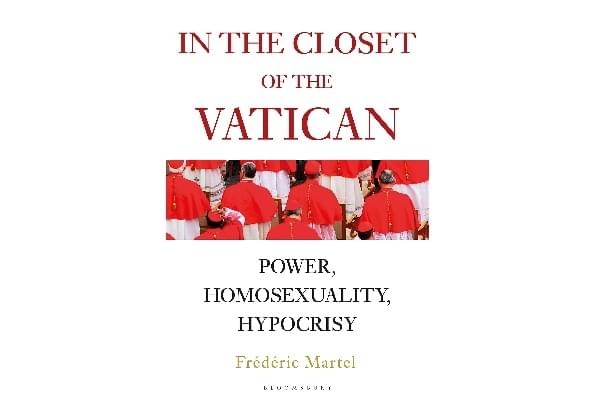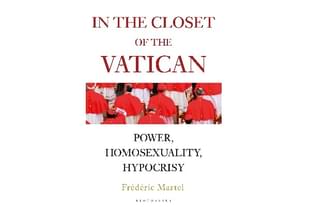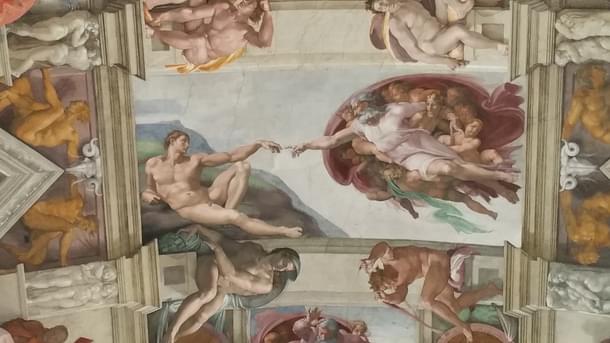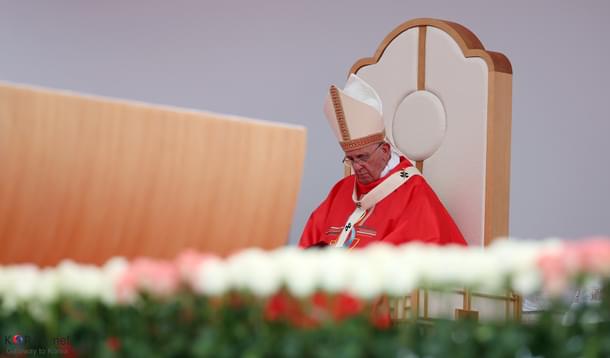Magazine
Mortal Desires, Divine Hypocrisy
Frederic Martel
Apr 30, 2019, 04:20 PM | Updated 04:20 PM IST
Save & read from anywhere!
Bookmark stories for easy access on any device or the Swarajya app.


In the Closet of the Vatican: Power, Homosexuality, Hypocrisy. Frederic Martel. Bloomsbury Continuum. Rs 1,746. Pages 576.
‘He’s of the parish,’ the priest whispers conspiratorially in my ear.
The first person who used that coded expression in front of me was an archbishop from the Roman Curia.
‘You know, he’s very practising. He’s of the parish,’ he stressed in a low voice, talking to me about the morals of a famous Vatican cardinal, a former ‘minister’ of John Paul II, who both of us knew well.
He added: ‘And if I told you all the things I know, you wouldn’t believe it!’
And, of course, he talked.
We will come across this archbishop several times again in the course of this book, the first in a long series of priests who described the reality of which I was already aware, but which many people will see as a fiction. A fairy tale.
‘The problem is that if you tell the truth about the “closet” and the special friendships in the Vatican, people won’t believe you. They’ll say it’s made up. Because here reality goes beyond fiction,’ I am told by a Franciscan friar, a man who has also worked and lived inside the Vatican for over thirty years.
But lots of people described this ‘closet’ to me. Some of them were worried about what I was going to reveal. Others disclosed secrets to me, first in a whisper, then shortly afterwards, in a loud voice: actual scandals. Others, last of all, proved to be loquacious, excessively so, as if they had been waiting for so many years to come out of their silence. About forty cardinals and hundreds of bishops, monsignori, priests and ‘nuncios’ (the pope’s ambassadors) agreed to meet me. Among them, alleged homosexuals, who were present in the Vatican every day, introduced me to their world of initiates.

Open secrets? Rumours? Evil gossip? I’m like St Thomas: I need to check to believe. So I had to spend a long time investigating and living immersed in the Church. I installed myself in Rome, one week every month, regularly inside the Vatican, thanks to the hospitality of senior prelates who sometimes revealed that they too were ‘part of the parish’. And then I travelled across the world, through more than thirty countries, among the clergies of Latin America, Asia, the United States and the Middle East, to collect over a thousand statements. During that long investigation I spent more than a hundred and fifty nights a year reporting, away from home, away from Paris.
During the four years of that investigation, I never concealed my identity as a writer, a journalist or a researcher when approaching cardinals and priests, who sometimes proved to be unapproachable. All interviews were conducted under my real name, and my interlocutors had only to do a quick search on Google, Wikipedia, Facebook or Twitter to discover the details of my biography as a writer and reporter. Often, those priests, influential or otherwise, came on to me decorously, and some, with very little reluctance, more intensely. It’s an occupational hazard!
Why did these men, who were used to being silent, agree to break the omertà? That is one of the mysteries of this book and my reason for writing it.
What they told me was unsayable for a long time. It would have been difficult to publish a book like this twenty or even only ten years ago. For a long time, the ways of the Lord remained, if I may say so, impenetrable. They are less so today because the resignation of Benedict XVI and Pope Francis’s desire for reform have freed people’s tongues. Social networks, more courage on the part of the press, and countless ecclesiastical sex scandals have made it possible, and necessary, to reveal this secret today. So this book criticizes not the Church overall, but a very particular ‘genre’ within the gay community; it tells the story of the majority of those in the College of Cardinals and the Vatican.

Many cardinals and priests who officiate at the Roman Curia, most of those who meet up in conclave beneath the frescoes of the Sistine Chapel painted by Michelangelo – one of the most grandiose scenes of gay culture, peopled with virile bodies, surrounded by the Ignudi, those robust and beautiful naked young men – share the same ‘inclinations’. They have a ‘family resemblance’. In fact, in an aside that had something of the disco-queen about it, another priest whispered to me in English: ‘We are family!’
Most of the monsignori who have spoken at the balcony of the Loggia of St Peter’s, between the pontificate of Paul VI and that of Francis, to deliver the sad announcement of the death of the pope or, with frank gaiety, to say Habemus papam!, share the same secret. È Bianca!
Whether they are ‘practising’, ‘homophile’, ‘initiates’, ‘unstraights’, ‘wordly’, ‘versatile’, ‘questioning’, or simply ‘in the closet’, the world I am discovering, with its 50 shades of gay, is beyond comprehension. The intimate stories of these men who give an image of piety in public and lead a quite different life in private, so different from one another, present us with a complex intrigue to unravel. Never, perhaps, have the appearances of an institution been so deceptive; and equally deceptive are the pronouncements about celibacy and the vows of chastity that conceal a completely different reality.
The best-kept secret of the Vatican is no secret to Pope Francis. He knows his ‘parish’. Since arriving in Rome he has known that he is dealing with an organisation that is quite extraordinary in its way, and that isn’t restricted, as people believed for a long time, to a few lost sheep. It’s a system; and a huge herd. How many are there? It doesn’t matter. Let’s just say: they represent the great majority.
At first, of course, the pope was surprised by the extent of that ‘malicious colony’, its ‘charming qualities’ and its ‘unbearable shortcomings’ of which the French writer Marcel Proust wrote in his celebrated book Sodom and Gomorrah. But what Francis is unable to bear is not so much the homophilia that is so widespread, as the dizzying hypocrisy of those who advocate a rigid morality while at the same time having a companion, affairs and sometimes escorts. That’s why he spends so much time denouncing fake devotees, whited sepulchres and hypocrites. Francis has often denounced this duplicity in his morning homilies from Santa Marta. His phrase should be placed as an epigram at the start of this book: ‘Behind rigidity something always lies hidden; in many cases, a double life.’
Double life? The phrase has been uttered, and this time the evidence cannot be challenged. Francis has often repeated his criticisms of the Roman Curia: he has pointed his finger at the ‘hypocrites’ who live ‘hidden and often dissolute lives’; the ones who ‘put make-up on their souls and live off make-up’; the ‘lie’ erected into a system that does ‘a lot of harm, hypocrisy does a lot of harm: it’s a way of life’. Do as I say, not as I do!
Do I need to say that Francis knows the people he addresses in this way without naming them: cardinals, papal masters of ceremonies, former secretaries of state, deputies, minor assistants or chamberlains? In most cases it isn’t simply a general inclination, of a certain fluidity, homophilia or ‘tendencies’, as people said at the time, nor even repressed or sublimated sexuality, all equally prevalent in the Church of Rome. Many of these cardinals who ‘have not loved women, for all the blood that flows in their veins!’, as the Poet says, are practising. What detours I am taking to say such simple things – things which, so shocking yesterday, are so banal today!
Practising, certainly, but still ‘in the closet’. I don’t need to introduce you to this cardinal who appears in public on the balcony of the Loggia, and who was caught up in a quickly suppressed case of prostitution; this other French cardinal who for a long time had an Anglican lover in America; or this other one who, in his youth, had a chain of adventures like the beads on a nun’s rosary; not forgetting those who live with their boyfriends in the palaces of the Vatican, where I have met them; they introduced their companions as their assistants, their minutante, their deputy, their chauffeur, their valet, their factotum, even their bodyguard!
The Vatican has one of the biggest gay communities in the world, and I doubt whether, even in San Francisco’s Castro, the emblematic gay quarter, though more mixed today, there are quite as many gays!
The reason for this, among the older cardinals, should be sought in the past: their stormy youths and roguish years before gay liberation explain their double lives and their homophobia in the old style. I’ve often had a sense during my investigation that I’ve gone back in time and found myself in the 1930s or 1950s, years that I haven’t known myself, with the dual mentality of the chosen people and the cursed people, which led one of the priests that I met often to say: ‘Welcome to Sodoma!’
I’m not the first to discuss this phenomenon. A number of journalists have already revealed scandals and affairs within the Roman Curia. But that isn’t my subject. Unlike those Vaticanologists, who denounce individual ‘excesses’ but in such a way as to conceal the ‘system’, I am less concerned with exposing these affairs than with revealing the very banal double life of most of the dignitaries of the Church. Not the exceptions but the system and the model, what American sociologists call ‘the pattern’.
The details, certainly, but also the great laws – and there are, as we will see, 14 general rules in this book. The subject is: the intimate society of priests, their fragility, and the suffering bound up with forced celibacy, which has become a system. So it is not a matter of judging these homosexuals, even the closeted ones – I like them! – but of understanding their secret and collective way of life. It is not a matter of denouncing these men, nor of ‘outing’ them while they are alive.
My project isn’t about ‘naming and shaming’, the American practice of making names public in order to expose them. Let it be clear that for me a priest or a cardinal should not be ashamed about being homosexual; I even think it should be one possible social status among others.
But one becomes aware of the need to expose a system built, from the smallest seminaries to the holy of holies – the cardinals’ college – both on the homosexual double life and on the most dizzying homophobia. Fifty years after Stonewall, the gay revolution in the United States, the Vatican is the last bastion still to be liberated! Many Catholics now have a sense of this lie without yet having been able to read the revelations in this book.
Without this key for understanding, the recent history of the Vatican and the Roman Church remains opaque. By failing to recognize the broadly homosexual dimension, we deprive ourselves of one of the keys to a greater understanding of most of the facts that have stained the history of the Vatican for decades: the secret motivations that led Paul VI to confirm the prohibition on artificial contraception, the rejection of condoms and the strict obligation of celibacy on the priesthood; the war against ‘liberation theology’; the scandals of the Vatican Bank in the time of the famous Archbishop Marcinkus (he too was a homosexual); the decision to forbid condoms as a way of battling AIDS, even when the pandemic would lead to more than thirty-five million deaths; the VatiLeaks I and II affairs; the recurrent and often unfathomable misogyny of many cardinals and bishops; the resignation of Benedict XVI; the current rebellion against Pope Francis … Every time, homosexuality plays a central part that many people can only guess at, and the truth of which has never really been told.
The gay dimension doesn’t explain everything, of course, but it is key for anyone wishing to understand the Vatican and its moral postures. We might also put forward the hypothesis, even though it isn’t the subject of this book, that lesbianism is a major key to an understanding of convent life, whether that of cloistered orders or not.
Lastly – alas! – homosexuality is also one of the keys that explain the institutionalized cover-up of sexual crimes and misdemeanours, of which there are now tens of thousands. Why? How? Because the ‘culture of secrecy’, which was necessary to maintain silence about the huge presence of homosexuality inside the Church, has made it possible to hide sexual abuse, and for predators to benefit from this system of protection within the institution – even though paedophilia is not the subject of this book.
‘How much filth there is in the Church,’ said Cardinal Ratzinger, who also discovered the extent of the ‘closet’ through a secret report by three cardinals, the content of which was described to me and that was one of the major reasons for his resignation. This report is said to reveal not so much the existence of a ‘gay lobby’, as was said, as the omnipresence of homosexuals in the Vatican, blackmail and harassment built into the system. There is, as Hamlet might have said, something rotten in the state of the Vatican.
The homosexual sociology of Catholicism also helps us to explain another reality: the end of vocations in Europe. For a long time, as we will see, young Italians who discovered that they were homosexual, or who had doubts about their inclinations, chose the priesthood. So these pariahs became initiates and made a strength of a weakness. With the homosexual liberation of the 1970s, and particularly since the gay socialization of the 1980s, Catholic vocations, especially in European countries, have naturally fallen. A gay adolescent today has other options, even in Italy, apart from entering holy orders. The lack of vocations has multiple causes, but the homosexual revolution is paradoxically one of the main forces behind it.
Frederic Martel (PhD) is a French writer and researcher. He is also a journalist at National Public Radio and the author of ten books, which have been translated and published in more than 25 countries. He lives in Paris. ‘In the Closet of the Vatican’ is published simultaneously in eight languages.





